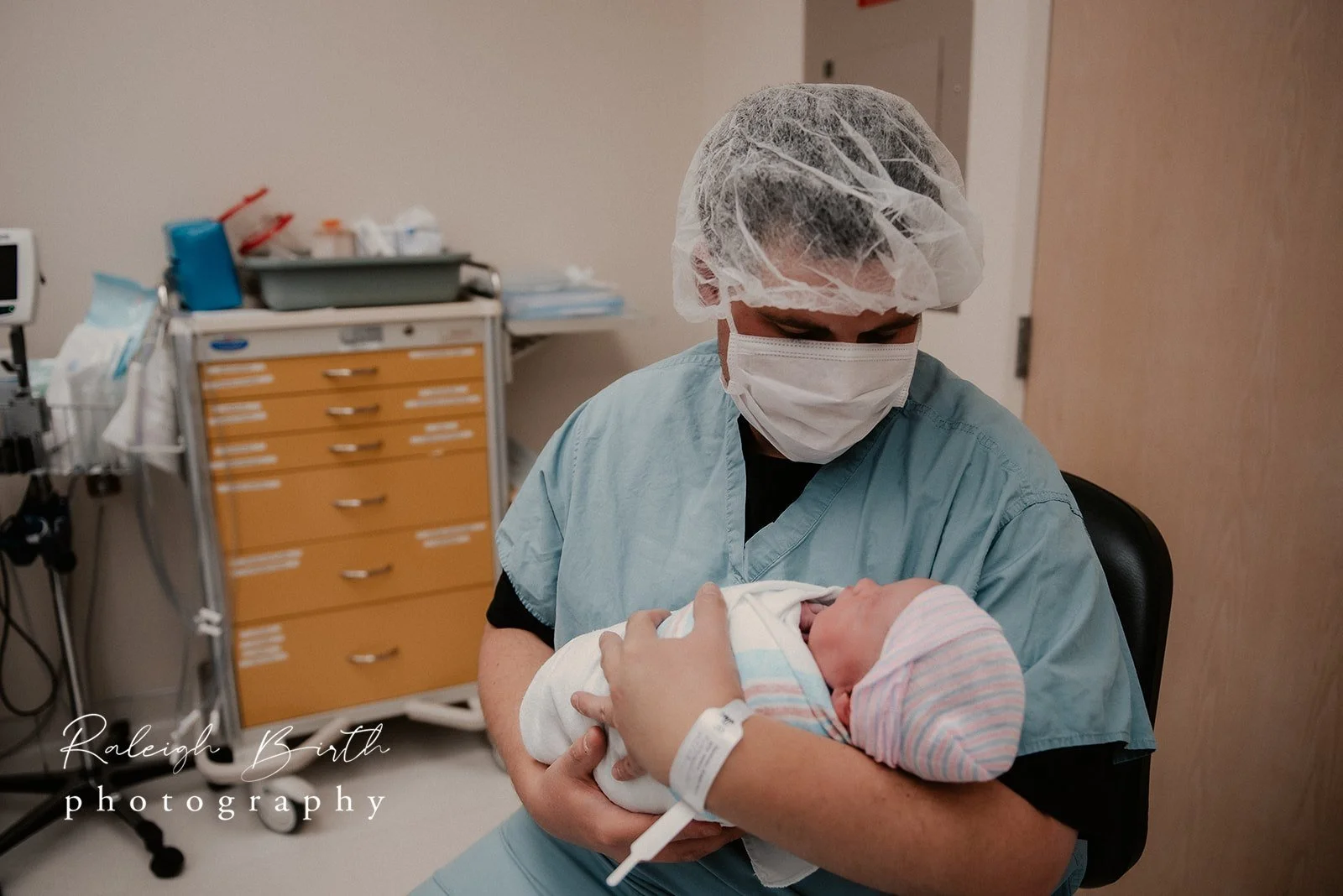What if I have a Cesarean?
What happens if my birth plan ends in a C-Section?
Cesarean birth may be a choice or an unexpected situation, evoking a range of emotions from feeling prepared and ready to vulnerable and fearful. As a mother who experienced an unplanned cesarean, I understand the importance of considering plans and realities related to this type of birth. Today, I want to share insights into both expected and unexpected aspects of a Cesarean birth, offering you valuable information for a more informed and empowered experience.
So, you've chosen Cesarean birth as the best option for you, either due to pre-existing risks, decisions made during labor, or personal preference. Understanding what happens next can be both valuable and empowering. Let's delve into the journey, exploring the birth space, duration, sensations, and the immediate care your newborn will receive.
What Happens First?
Once you have decided on a cesarean birth you’ll likely be given the necessary hospital gown and sometimes hair net for surgery. It’s common for you to be taken back alone ideally with the support of the nurse you are familiar with. Your birth partner will likely not be able to accompany you at first. So you may experience some separation until they have you prepped and ready to invite your partner to sit by your head for the actual cesarean birth portion.
What Is the Birth Space Like?
The OR (operating room) can often feel like a mysterious place. Very few of us are familiar with the surgical setting and often with emergent births it can all happen very fast. Faster than you have time to take it in and process. The room itself is tiny but there are a lot of people in there. It can feel overwhelming and crowded. Don’t be surprised if you see 8-10 Nurses and Doctors filling the space each with their own focus and role during the birth. You’ll likely be spoken to only by a few of the people in the room, the anesthesiologist, the nurse who’s job is to support you, and possibly the Dr. Performing the surgery.
How Long Does It Take?
Cesarean births unfold surprisingly fast, with the baby usually born within 15 minutes of settling into the OR. The complete surgical process, including repairs, takes 30-45 minutes before you're ready for transfer to the maternity floor. While this timeline is common, unexpected factors like excess bleeding may extend the duration.
What Does It Feel Like?
It should feel like light pressure only. You shouldn’t experience any sharp pain during the surgery. So if you are feeling pain of any sort, be sure to inform your anesthesiologist or nurse immediately so they can either increase your numbing or give you additional medicines to eliminate the pain.
What Happens to My Newborn?
Following the surgery, your baby is usually assessed in an warmer. If immediate skin-to-skin contact in the OR isn't requested, you may not see your baby for a while. The nursing team typically rushes through checks and procedures, after which your baby may be handed to your partner or to you, depending on your preference. Most of these procedures can sometimes wait (things like adding a hospital band, adding ointment, wiping baby down, and weighing them) so if it’s important to you to be with baby immediately make sure this is known and communicated.
If your newborn has additional needs or struggles immediately after birth they may be taken off to the NICU straight from the OR. In most cases, families are encouraged and given access to baby and the NICU as soon as your are physically able. Even through just wheeling your bed down to the NICU so you can meet baby and be with them.
What Are My Options?
Planning your cesarean is an amazing way to feel empowered and in control of your birthing experience. It’s important to have these ideas written down in case of fast paced emergency or if you have time it’s important to sit with your Doctor before surgery to advocate for your preferences. Some of the changes and options you can choose and discuss are,
Making the OR Space Your Own
Adjust the energy in the room. Calm music or music of your choice being played to welcome baby can be a great way to make the OR feel less sterile. You can also request dimmed lights or no talking. This allows the OR space to feel a little more sacred and peaceful.Request a Clear Drape
Using a clear drape during surgery or when baby is lifted up. This can be a great way for you to see baby as soon as they are born and help you to feel more apart of the experience instead of disconnected from what’s happening with the rest of your body. Immediate Skin to Skin
Immediate skin to skin with baby there in the OR is a wonderful way to begin bonding. Not only that, Skin to skin produces major doses of oxytocin that are often low during a surgical birth so having those moments of connection and bonding can be crucial. Oxytocin calms both you and baby and triggers your milk supply for a healthy breastfeeding relationship. Studies also show that oxygen levels for baby after a cesarean can be lower than that of a vaginal birth but skin to skin can be an amazing way to regulate baby’s warmth, heart rate, breathing, and oxygen levels as they transition into the world. It also supports you and baby on a mental and holistic level. In some cesarean births, the disconnection of your body and physiological birth can cause a lot of mental blocks. Encouraging immediate bonding can help you and baby naturally transition into a deep connection.Breastfeeding in the OR
Immediate initiation and support of breastfeeding in the OR. Similar to skin to skin it can be so amazing to start breastfeeding seconds after birth if baby is ready. So making sure your nurse and the team around you are aware of this goal is the best way to feel supported. You will still be groggy and effected by the surgery so it won’t feel as natural at first but with the help of your partner and supportive team it can be a great way to start your breastfeeding journey off.Including Your Doula and/or Birth Photographer
Including your doula and/or birth photographer into the OR to capture and celebrate the moments you can’t see for you. Thankfully many of our hospitals here in the Triangle offer this but it is always up to you to advocate for this added support. If it’s important to you to have these moments documented or to have that additional doula care you should let your health provider know. While it can be a crowded space I have had the honor of photographing many cesarean births and supporting cesarean families through the whole process right by their side. If for some reason they don’t allow it or are unable to make space, it can be an option to give a nurse the camera or your partner to take it back to the OR. You may not capture everything or the highest quality with out a professional behind the lens, but honestly having anything from that time can be a healing and empowering way to connect to your birth experience and story. Delayed cord clamping and saving your placenta
Delayed cord clamping and saving your placenta are also great ways to support your baby and postpartum. Make sure you request this early and let the Dr know that this is important for you. The placenta will get whisked away into hospital waste if you don’t let your nurse and team know you want to take it home or see it after surgery. So be sure to make plans for your placenta and let them know them before the surgery starts. Maternal Assisted Cesarean
Maternal Assisted Cesarean is also a growing birth plan. Where the birthing person is given gloves and able to reach and lift their own baby from the incision on their stomach. I’ve not been able to witness one here in the Triangle but one day I hope to support a family with this. It truly takes the right Doctor and right family to advocate for this opportunity. What Is Postpartum Healing Like After a Cesarean?
Recovery is typically longer for those who have a csection so it’s important to be very patient with your body and slow getting back to ‘normal’ once you are home. You will likely stay extra days in the hospital as well. While our culture expects a bounce back after birth that is rarely the reality and very uncommon after a cesarean birth. Its incredibly common to need several additional weeks for recovery and healing, 6-10 weeks is a normal for low activity post-op. Your will also experience the typical level of bleeding even though you did not have a vaginal birth.
What Happens to My C-section Scar?
Your incision scar may feel sore or painful even months after the surgery. But in time it should heal and become unnoticeable. There are a few healing tips that may help.
Once your scar is healed fully you can also try scar massage. Massaging your scar regularly can help to break down the scar tissue underneath which can help reduce pain and long term sensitivity. It helps to use coconut oil or lotion for the massage.Vitamin E oil may help in fading the color and puffiness faster. But it will also naturally fade to a pale skin tone on its own with time.
What Are My Options for a VBAC?









